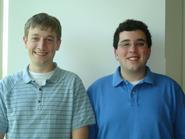
Physics students David Shapiro '07 and Daniel Tomb '08 are spending eight
weeks this summer working on a research project that Hamilton students have been working on for several years. The aCORN ('a' CORrelation in Neutron decay) project began in 1998 and is a collaboration between Hamilton, Indiana University, DePauw University, Tulane University, NIST, and Harvard University. The goal of aCORN is to measure the beta-neutrino angular correlation coefficient in neutron beta decay, often called the "Little a" coefficient. This correlation can be calculated in the Standard Model which describes the weak force, one of the four fundamental forces in nature.
Under the supervision of Associate Professors of Physics Gordon Jones and Brian Collett, Hamilton students have been working on creating the very precise magnetic field required for the experiment. Last year, Josh Newman '06 created a prototype of the robot that will measure the three-meter tall magnetic field. "Our job is to pick up where Josh stopped," said Shapiro, who plans to continue his work on the project for
his senior thesis in the upcoming year. The magnetic field needs to be completely uniform. "If the field isn't accurate, the experiment won't be accurate," said Tomb. Shapiro and Tomb are currently working on a prototype and hope to have it working this summer.
The first phase of the aCORN project may have an end in sight. The current goal is for Hamilton students and faculty to bring their work to Indiana University in January, where all of the different pieces of the experiment will be assembled and experimental trials will begin. Late next year the project will be moved to the National Institute of Standards and Technology in Washington D.C.
Tomb, who spent the last two summers working in Winslow Professor of Chemistry's George Shields's lab, is no stranger to summer research. "It's the best kind of summer job," he said. "It's a wonderful opportunity to work with and get to know our professors." A physics and math major, he chose Hamilton in part because of the emphasis on undergraduate research.
Shapiro, who is new to summer research, wanted to get a head start on his thesis work. "I wanted to make my thesis worthwhile," he said, by putting more than the requisite four months into it. He also wanted to gain some more insight into a career in physics. "I like physics, but I don't know what I want to do," said Shapiro, who is considering teaching.
The most difficult part of the research, said Shapiro and Tomb, is starting work on a project that is not new. "We have to figure out what everyone else has already done and understand the big picture," said Tomb. Still, working on such a large and important project is exciting and both Shapiro and Tomb hope to continue their work through the move of the materials to Indiana.
-- by Laura Trubiano '07
Posted July 17, 2006
